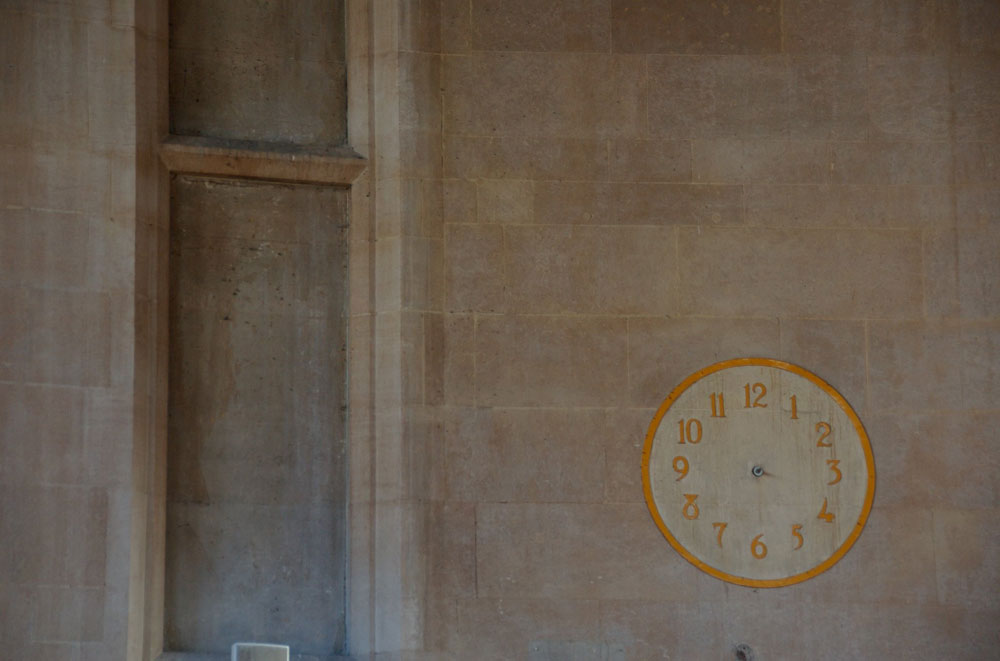
Design theorist Tony Fry warns us that one of the key things we have to reorient around as we design for social change now is our concept of time. In Design as Politics, he writes,
No matter the differences of our circumstances as individuals, cultures, or nations, we now share a time that is new. We all share a continual moment of the diminishment of time. The actual finite time of our life on the planet (and the life of much else) is being reduced by our own destructive actions as a species. (49-50)
He notes that, at most, we have 30 years—not to turn things around, but to create a new order that adds time, or life, back in. We need to design in time; that is, design with a sense of how much time we actually have in which to make social change. He calls this new, life-giving order Sustainment.
Fry adds that, “The most overt sign…will be the hundreds of millions of environmental refugees created by climate change as the century rolls on.” (50)
We are already starting to see both our failure to design in time and the effect of climate refugees. Recent news stories illustrate this.
CityLab’s Linda Poon writes about what data from relocations in the US between 2004 and 2014 as a result of Hurricanes Katrina and Rita are telling us about future migration patterns. Lead researcher Bistra Dilkina, an engineering professor at the University of Southern California, says, “A lot of cities not at risk of sea level rise will experience the effect of it. This will require an adjustment in terms of the [increased] demand on the cities’ infrastructure.”
So, while the worst-case scenario has the East and West coasts, as well as the Gulf of Mexico, under water, cities close to these areas, “and that aren’t typically attractive destinations for newcomers,” will see an increase of migrants. The study finds that “people tend to move to familiar places nearby, where they might already have friends, family, or some support network.” They may also “flock to major urban centers like Dallas and Houston…and drive up the pace of urbanization.”
The first impact cities may feel is a housing crunch. Chico, California started experiencing this after the 2018 wildfires, becoming a boom town overnight, with home sales doubling and prices jumping 21 percent. This may, in turn, increase displacement and even homelessness for local populations, a phenomenon called “climate gentrification.”
Further, those with means will start relocating, many perhaps to the suburbs of the Midwest, “where the model shows a larger-than-average influx of migrants compared to historic trends.”
Another major effect of climate change, besides sea level rise, is heat waves, which the study’s model predicts will drive migration in the US northward “and could make cities like Duluth and Buffalo ‘climate havens.’”
The study hopes that the message that will get across is that significant numbers of people will be on the move, socioeconomic factors will play a role in how people move and where, and policymakers need to start designing this into current infrastructure investments.
For example, Jesse Keenan, a climate adaptation expert at Harvard University, asks, “So if we’re going to build a road, is this for today’s population or is this for tomorrow’s population?”
This is exactly what Fry means when he tells us we have to start planning backwards from the future, say, the year 2050.
Not only is an increase in mass migration, which globally already totals 20 million people a year, likely, but the people migrating will be not just plural (that is, living with difference) but post-national. Fry expects increased conflict and a new human psyche in response to increased risk. How we go depends on our ability to design for the future we want. New ways of being and being together will be necessary for the scale of change needed. This is the hardest part of the work.
Sign up for our free newsletters
Subscribe to NPQ's newsletters to have our top stories delivered directly to your inbox.
By signing up, you agree to our privacy policy and terms of use, and to receive messages from NPQ and our partners.
Fry started out as a sustainability designer, but quickly saw that his projects were beyond designing toward a more ideal, sustainable, state. They were about massive relocations of cities and towns. In this video, in which he describes this work, he says that the technical part is the easiest. The hardest part about migration is giving people a reason to move and creating a social and political order in the new place.
Another City Lab article, Jeremy Deaton’s “Will Buffalo Become a Climate Change Haven?,” is an excellent in-time example of the aforementioned. When SUNY Buffalo State climate scientist Stephen Vermette set out to study climate change in Buffalo in 2016, looking at weather patterns back to 1965, he found that, while temperatures had “risen a little more than 2 degrees Fahrenheit over that time, roughly consistent with the rest of the Lower 48…climate change has left western New York mostly untouched.”
He found no evidence of increased rainfall or heat wave; “the breeze off of Lake Erie acts like a natural air conditioner, helping to keep the city cool.”
At first, Vermette thought there was an error, but then he realized he’d accidentally found a climate haven.
Deaton writes, “Buffalo is unusually well-insulated against climate change…Experts say the region’s cool climate and ample fresh water could make it an attractive destination as the planet heats up.”
And, he observes, “These facts have not gone unnoticed. In his 2019 State of the City address, the mayor dubbed Buffalo a ‘Climate Refuge City.’ Civic leaders are hopeful that the coming wave of climate refugees will revive Buffalo, filling its vacant lots and abandoned storefronts.”
He continues,
Notably that speech included no mention of what the city was doing to prepare for the expected influx of climate refugees — no new blue-ribbon committees, no new policy announcements.
“I heard that line, and I was waiting for something else to come out of his comment, and there was nothing,” Vermette said. “There is no initiative by the city. There is no embracing what we’ve done here. It was just a thing to say.”
Deaton asks, “As Buffalo becomes a more appealing place to migrate, can it remain a haven for refugees like [Maria] Robles [a recent climate migrant from Puerto Rico], who come in search of affordable housing and a decent job? Or will Buffalo become a cold-weather haven for the professional class?”
So far, he observes, ““They’re frustrated because they can’t figure out how to get this square peg called ‘equity, equality, justice’ into this round hole called ‘the market.’” And, like Fry, he warns us, “It won’t happen naturally. We’ll have to fight to make that occur.” And yet, as Fry points out, Sustainment “cannot be attained without equity.” (82)
This article was originally published on March 10, 2020.













